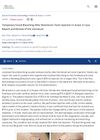Search
for
Sort by
Research
180-210 / 1000+ results
research Non-Edg Family LPA Receptors: The Cutting Edge of LPA Research
New LPA receptors (LPA4, LPA5, LPA6) have diverse roles in the body.

research Ganoderma Lucidum Extract Attenuates Corticotropin-Releasing Hormone Induced Cellular Senescence in Human Hair Follicle Cells
Ganoderma lucidum extract may help treat stress-related hair loss.

research Fibroblast Growth Factors: Key Players in Regeneration and Tissue Repair
Fibroblast Growth Factors (FGFs) are important for tissue repair and regeneration, influencing cell behavior and other factors involved in healing, and are crucial in processes like wound healing, bone repair, and hair growth.

research Wound Healing and Skin Regeneration
Hair growth phase and certain genes can speed up wound healing, while an inflammatory mediator can slow down new hair growth after a wound. Understanding these factors can improve tissue regeneration during wound healing.

research Temporary Facial Blanching After Botulinum Toxin Injection in Asians: A Case Report and Literature Review
Temporary facial blanching can occur after Botulinum toxin injections, but it resolves without discomfort.

research Stress-Related Skin Disorders
Stress can worsen skin conditions by affecting hormone levels and immune response.

research Molecular and Spatial Design of Early Skin Development
The research reveals how early embryonic mouse skin develops from simple to complex structures, identifying various cell types and their roles in this process.

research SOX2 in the Skin: Roles in Biology and Pathology
SOX2 is crucial for skin cell function and hair growth, and it plays a role in skin cancer and wound healing.

research Hair Growth Modulation by Adrenergic Drugs
Certain drugs can cause early hair growth in mice by affecting the nerves.

research Molecular Control of Epithelial-Mesenchymal Interactions During Hair Follicle Cycling
Epithelial-mesenchymal interactions control hair growth cycles through specific molecular signals.

research Dermal Papilla Cells: From Basic Research to Translational Applications
Dermal papilla cells can help regrow hair and are promising for hair loss treatments.
research Revisiting the Role of Melatonin in Human Melanocyte Physiology: A Skin Context Perspective
Melatonin affects skin and hair color and protects skin cells, with potential benefits for hair growth and skin health.

research Indian Hedgehog Controls Proliferation and Differentiation in Skin Tumorigenesis and Protects Against Malignant Progression
Indian Hedgehog helps control skin cell growth and protects against aggressive skin cancer.

research Calcium Channel Inhibitor and Extracellular Calcium Improve Aminoglycoside-Induced Hair Cell Loss in Zebrafish
Certain substances can protect against ear damage from some antibiotics in zebrafish.

research An Integrative View of Mammalian Seasonal Neuroendocrinology
The article concludes that better understanding gene regulation related to seasonal changes can offer insights into the mechanisms of seasonal timing in mammals.

research Low-Level Laser and Light Therapy
Low-Level Laser Therapy can stimulate healing and cell function, potentially leading to wider medical use.

research TGF-β2 Is Specifically Expressed in Human Dermal Papilla Cells and Modulates Hair Folliculogenesis
TGF-β2 plays a key role in human hair growth and development.

research Recent Advances in Exosomal Non-Coding RNA-Based Therapeutic Approaches for Photoaging
New treatments for skin damage from UV light using stem cells and their secretions show promise for skin repair without major risks.

research In Vitro Strategies for Mimicking Dynamic Cell–ECM Reciprocity in 3D Culture Models
The conclusion is that accurately replicating the complexity of the extracellular matrix in the lab is crucial for creating realistic human tissue models.
research Cutaneous Manifestations of Diabetic Peripheral Neuropathy
Skin and nail problems like hair loss, dry skin, and fungal infections are common in people with long-term Type 2 Diabetes and can be prevented with good blood sugar control and foot care.

research Whole Neonatal Cochlear Explants as an In Vitro Model
The new method makes it easier to study the whole cochlea from newborn mice and rats in the lab.

research Alopecia
The document concludes that alopecia has significant social and psychological effects, leading to a market for hair loss treatments.

research Therapeutic Potential of Extracellular Vesicles (Exosomes) Derived From Platelet-Rich Plasma: A Literature Review
Exosomes from platelet-rich plasma may help heal wounds but need more research for hair growth and skin use.

research The Prolactin Receptor as a Therapeutic Target in Human Diseases: Exploring New Potential Indications
Blocking the prolactin receptor might help treat various diseases, but more research is needed.

research Stress, Hair Growth Control, and the Neuro-Endocrine-Immune Connection
Stress may affect hair growth by influencing hair follicle development and could contribute to hair loss.

research Is Radical Prostatectomy the Best Choice for Patients with Locally Advanced Prostate Cancer?
The document does not confirm if radical prostatectomy is the best treatment for locally advanced prostate cancer.

research Hair Follicles’ Transit-Amplifying Cells Govern Concurrent Dermal Adipocyte Production Through Sonic Hedgehog
Cells in hair follicles help create fat cells in the skin by releasing a protein called Sonic Hedgehog.

research Toll-Like Receptor 4 (TLR4): New Insights into Immunity and Aging
TLR4 is important in aging-related diseases and could be a new treatment target.

research Fresh Umbilical Cord Blood as a Source of Multipotent Stem Cells: Collection, Banking, Cryopreservation, and Ethical Concerns
Umbilical cord blood is a valuable source of stem cells for medical treatments, but its use is less common than other transplants, and there are ethical issues to consider.